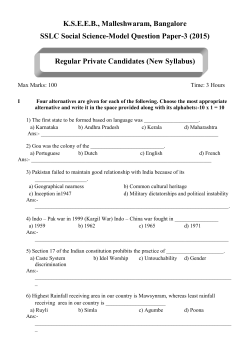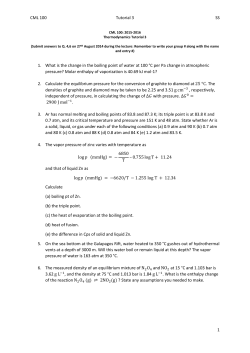
Practice problems
Practice problems 1. The molar volumes of solid and liquid lead at the normal melting temperature of lead are, respectively18.92 cm3 and 19.47 cm3. Calculate the pressure that must be applied to lead to increase its melting temperature by 20 degrees centigrade. Hint: use the Clapeyron equation. Ans: The pressure must be increased to 2822 Atm. 2. Two ideal gases mix according to the ideal solution model. Consider n moles of ideal gas A and (1-n) moles of ideal gas B, each at 1 atm pressure, mixed at toal constant pressure and fixed temperature. (a) What value of n in the mixture maximizes the decrease in Gibbs free enrgy of the system? (b) If this decrease in Gibbs free energy of the system is ΔGmix, to what value must the pressure be increase in order to increase the Gibbs free energy of the gas mixture by 1/2 ΔGmix? Hint for (b). consider dG = Vdp at fixed T. Use the ideal gas law to relate V to p and integrate to get G. Ans: (a) n = 0.5 (b) p = 1.414 Atm. 3. Use the Gibbs-Duhem equation to show that, if the activity coefficients of the components in a binary solution can be expressed as 1 1 ln γ A = α1 X B + α 2 X B2 + α 3 X B3 + ... 2 3 and 1 1 ln γ B = β1 X A + β 2 X A2 + β3 X A3 + ... 2 3 over the entire range of composition, then α1 = β1 = 0 and that, if the variation can be represented by quadratic terms alone, then α2 = β2. 4. The activity coefficient of Zn in liquid ZnCd alloys at 435 °C can be reperesented 2 3 as ln γ Zn = 0.875X Cd . Derive the corresponding expression for the − 0.30 X Cd dependence of lnγCd on composition and calculate the activity of Cd in the alloy at XCd = 0.5 at 435 °C. 2 3 Ans: ln γ Cd = 0.425X Zn , at XCd = 0.5, γCd = 1.155 and aCd = 0.577 + 0.30 X Zn
© Copyright 2025





















